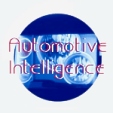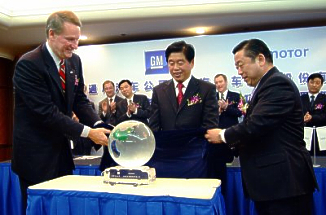
.
November
02, 2005
.
This Week:
-
GM and SAIC to Develop, Produce Energy-Efficient and Environmentally Clean Vehicles in China
-
MINI Cooper S with John Cooper Works GP Kit : More power, less weight
-
Toyota Builds on the Past, Looks to the Future in 2005 North American Environmental Report
-
Nissan Revenue Up 12.1%, Operating Profit Up 2% in FY05 First Half
-
General Motors to Build 1.55 Million Vehicles with Factory-Installed XM Satellite Radio in 2006
© 1998
- 2005 Copyright &
Disclaimer
Automotive Intelligence,
www.autointell.com
All Rights Reserved .
For questions please contact
editor@autointell.net
|
.
General Motors Chairman and CEO Rick Wagoner (left) and Shanghai Automotive Industry Corp. Group President Hu Maoyuan (right) present a special gift to Vice Mayor Hu and the Shanghai Municipal Government to mark the signing of a Memorandum of Understanding in Shanghai Saturday, October 29, 2005, to develop and produce energy-efficient and environmentally clean vehicles in China. Shanghai, China - General Motors Corp. (GM) Chairman and CEO Rick Wagoner and SAIC Motor Corp. Ltd. (SAIC Motor) Chairman Hu Maoyuan signed a Memorandum of Understanding today in Shanghai to explore opportunities for the local application and production of energy-efficient and environmentally clean vehicles in China. The two partners will explore the expansion of the current GM-Allison-SAIC hybrid demo bus program announced last October to a larger bus fleet for Shanghai's mass transportation system in advance of the 2010 World Expo in Shanghai.
|
|
According to Rick Wagoner, the two companies have the technical advantage of their Pan Asia Technical Automotive Center (PATAC) joint venture in Shanghai. The well-established, eight-year-old local engineering and design center will be responsible for hybrid system application engineering and integration in vehicles.
PATAC's designers, engineers and technicians will be involved in a number of hybrid programs applicable to vehicles manufactured by Shanghai GM. They will build complete demonstration vehicles, assessing various hybrid concepts for near-term production and developing local competency in regenerative braking, electric power steering and high-voltage battery systems.
Many of these technologies may have direct application in the development of hydrogen fuel cell vehicles, which both GM and SAIC believe is the ultimate solution to taking the motor vehicle out of the environmental equation, guaranteeing energy security and enabling a greater number of people to have access to environmentally clean personal transportation.
"To make this happen, we need to bring down costs and build the necessary infrastructure - and the best way to do that is by business and government working together," Wagoner said.
"The collaboration between SAIC and GM brings together the best resources that our two countries and their two industry leaders have to offer," Wagoner added. "As a company with a major stake in China, GM believes that we must focus on the industry of tomorrow. By working together, we can help take China one step closer to the era of sustainable transportation."
"SAIC Motor will focus on technology and innovation in the development of clean energy vehicles," said Hu Maoyuan. "We will work closely with research institutions to actively promote the development of key technologies. We also attach great importance to cooperation with our joint venture partner. By further strengthening our partnerships and enabling our joint ventures to play a major role in the development process, we hope to get clean energy vehicles to the market at the earliest possible date."
Today's announcement builds on an earlier agreement signed by GM and SAIC in Shanghai on Oct. 30, 2004, for the development and commercialization of clean energy vehicles. The agreement includes a series of joint programs to promote hydrogen fuel cells and other advanced vehicle technologies.
As part of the earlier agreement, GM and SAIC have launched a local demonstration of the HydroGen3, GM's first fuel cell vehicle to go into commercial operation. The local HydroGen3 made its debut in September. The two companies are also planning to engage in discussions around infrastructure development and in dialogue around relevant standards and regulations. On Sept. 28, GM China and SAIC opened an exhibition on hydrogen fuel cell technology at the Shanghai Science and Technology Museum to educate the Chinese public on sustainable transportation.
(Oct 29, 2005)
| .
Homepage News Companies Management Publications Events Search . |
